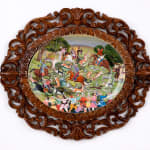Adeela Suleman
Haider Ali and Tipu witness the Qamargah hunt, 2023-24
Found vintage ceramic plate, hand painted with enamel paint and lacquer
Plate: 39.9 x 49.8 cm (15 3/4 x 19 5/8 in)
Framed: 72 x 82 x 16 cm (28 3/8 x 32 1/4 x 6 1/4 in)
Framed: 72 x 82 x 16 cm (28 3/8 x 32 1/4 x 6 1/4 in)
Further images
About Qamargah: The Mughal Emperors used hunting or shikar as a royal privilege, to exercise authority over their subjects and the natural world. The thrill of the hunt provided an...
About Qamargah: The Mughal Emperors used hunting or shikar as a royal privilege, to exercise authority over their subjects and the natural world. The thrill of the hunt provided an adrenaline rush that had the emperors hooked. Apart from casting themselves as heroes who could slay the fiercest of beasts, they believed that by hunting, they were destroying the forces of evil that surrounded them.
The majestic, big cats – tigers and lions- were especially challenging to Hunt and were therefore their most valuable quarry. The Mughals also believed that killing a lion or Tiger was a lucky omen. If the lion escaped during the hunt, trouble would befall the Empire.
The Mongol Tradition of hunting was about bringing out the warrior in an Emperor. Qamargah was a battle plan. Hundreds of men were employed as beaters, whose job was to trap the animal in a circle and lead it to an area encircled by nets or fences. Once trapped, the animal is then forced to Succumb to the authority of the emperor.
The lions and tigers have been removed from the composition and instead positioned between the men is young Tipu and his father, Haider Ali witnessing the royal hunt.
The majestic, big cats – tigers and lions- were especially challenging to Hunt and were therefore their most valuable quarry. The Mughals also believed that killing a lion or Tiger was a lucky omen. If the lion escaped during the hunt, trouble would befall the Empire.
The Mongol Tradition of hunting was about bringing out the warrior in an Emperor. Qamargah was a battle plan. Hundreds of men were employed as beaters, whose job was to trap the animal in a circle and lead it to an area encircled by nets or fences. Once trapped, the animal is then forced to Succumb to the authority of the emperor.
The lions and tigers have been removed from the composition and instead positioned between the men is young Tipu and his father, Haider Ali witnessing the royal hunt.
Exhibitions
Exit the Tiger, Symbols of Valour in Tipu's India, Adeela Suleman, 2 - 25 October 2024, Grosvenor Gallery, London, No. 2Join Our Mailing List
* denotes required fields
We will process the personal data you have supplied to communicate with you in accordance with our Privacy Policy. You can unsubscribe or change your preferences at any time by clicking the link in our emails.







